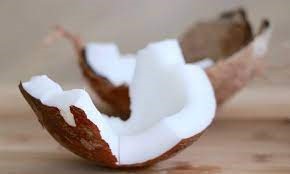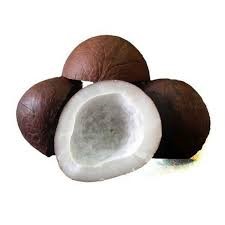Coconuts
The kernels of coconuts are called coconuts. Wet coconut is used in vegetables, amati, chutney and some dishes. It does not last more than 1 – 2 days, becomes crusty. However, it becomes durable when dried. Such coconuts are available in the market in the form of bowls (cracked) or gote (uncracked). A large part of the coconut production is used for making coconuts. The industry of extracting coconut oil (coconut) is also carried on on a large scale. This oil is edible and is also used in various cosmetics. Every year in India One and a half billion coconut make coconuts. Coconuts are produced in all coconut growing countries.

The people in and around the areas where coconuts are grown get fresh coconut almost throughout the year as per their requirements. Therefore, there may not have been much need to think about storing coconuts and coconut and exporting them earlier. But etc. S. Around 1860, due to the scarcity of fat obtained from milk production in Northern Europe, experiments were conducted to use coconut oil instead of cooking oil, butter etc. Although coconuts became widely used in Western Europe, coconuts were not even known in the United States until about 1910. In the second half of the twentieth century, world production of coconuts and coir was estimated at 22 to 24 lakh short tons (1 short ton is 907 kg or 2,000 pounds). It means that all the oils and fats of the world production. Eight percent of the production was from coconut only. Every year 13 to 15 lakh tonnes of oil is traded in the world trade. It is mainly imported to Western European countries and America.
Must read – Cumin
After one year, the coconuts begin to ripen on the hill and they begin to fall or shed. Harvesting of ripe coconuts is done throughout the year in all seasons. To get good quality coconuts, they have to go through many processes. They differ from country to country. The practice of storing coconuts for a few months after extraction is common in India and Sri Lanka. A sharp knife is used to remove the outer fibrous husk (leave) from the coconut. This is called coconut shelling. A skilled laborer can peel 3,000 coconuts in a day. In some places coconuts are extracted without peeling the coconuts by breaking them with an axe. Mechanical devices for peeling coconuts are also available. But mostly this work is done by hand everywhere. To make bowls of coconuts, usually the coconut is split into two halves with a sharp knife. A coconut contains 28 percent of its wet weight. It contains 50 percent water and 30-40 percent oil. 4 kg. Su for wet coconut. It takes thirty coconuts. The method of drying coconuts in the sun is the oldest and is still used in most places. Cracked coconuts in this way are spread on a clean ground with the coconut side facing the sun and sticking to each other. After keeping it in the sun for two-three days, the coconut leaves the karvanti more or less. It is removed and its bowls are dried again for 4-5 days. To make good quality coconuts, it needs to be dried continuously for 5-7 days. Coconuts made in rainy or cloudy days become rusty or their color is not pure white.

Uses
Coconut is edible and oil is also extracted from it. Coconuts are eaten alone or mixed into savory or sweet dishes. It is used in sweets. Vegetable spices include it. During the feast, some food is sprinkled with its kis. That makes them more attractive. Coconut bowls and bowls are used in some religious rituals.
‘Dried coconut’: To prepare this, the husk is first removed from the coconut and then the wet coconut is separated and the brown back is scraped off and the white coconut is made into thin slices or slices with the help of a machine and then it is dried in a hot vat drier. It is packed in tin lined boxes and exported. In Sri Lanka Ms. 6,900 coconuts make one tonne of ‘dry coconut’. In America, these are sold under the trade names ‘Macaroon’, ‘Thread’ and ‘Ribbon’. It is used in sweets, cakes, biscuits, puddings etc. Happens while making.
Read also – Chakraphula ( Star anise )
Tend-O-Nut: ‘Tend-O-Nut’ is the trade name for softened and sweetened desiccated coconuts. Presently it is produced in Sri Lanka. It contains 60 percent pure coconut, 38 percent sugar and 2 percent water. They produce seven pleasant colors pink, pale pink, brown, green, yellow, maroon and mauve. They are delicious and used to decorate cakes or as a filling in cakes. It is also consumed mixed with hot milk, tea or water.

Food use
Coconut oil is commonly used for cooking food. Especially when frying food, oil is used more. South Asian vegetables use coconut oil to flavor them.
Coconut water
One very important thing about coconut water is that after pregnancy, if a woman drinks coconut water regularly two to three times a week, the baby’s radiance improves and the baby’s color becomes brighter. Wet as well as dry coconuts are calming, energizing, stomach cleansing, of course, constipation relievers. It is also useful as a tonic. It improves skin health. However, excessive consumption of coconut increases cholesterol and increases the risk of heart attack.
Like to read – Coriander
Coconut Milk:
It has uses similar to coconut oil. Coconut milk is essential in Ghoan cuisine.
Coconut milk is best for nourishing dry skin. When the skin starts to feel dark, dull and dry due to dryness, regular coconut milk massage on the face will make the skin look plump and radiant again. In fact, coconut milk is a boon for the skin. Apart from this, coconut milk mixed with cream is also used during facial massage. Doing this helps in reducing the amount of wrinkles on the skin.
Like the skin, its milk is very nutritious and effective for the hair on the head. If the scalp skin and hair are not growing, the use of coconut milk will be beneficial. Crushing a vitamin E tablet in coconut milk and gently massaging the scalp with the mixture is beneficial. Doing this at least twice a week will definitely improve the health of your hair and scalp.
Source – Marathi vishwakosha
Read more –